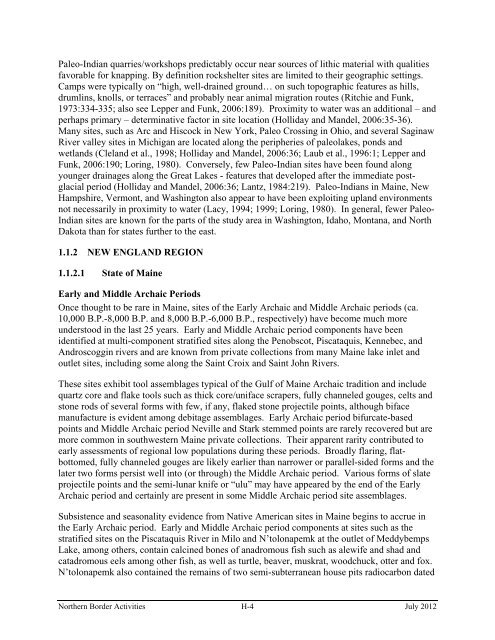Appendix H - Historical Archaeological and ... - CBP.gov
Appendix H - Historical Archaeological and ... - CBP.gov
Appendix H - Historical Archaeological and ... - CBP.gov
Create successful ePaper yourself
Turn your PDF publications into a flip-book with our unique Google optimized e-Paper software.
Paleo-Indian quarries/workshops predictably occur near sources of lithic material with qualities<br />
favorable for knapping. By definition rockshelter sites are limited to their geographic settings.<br />
Camps were typically on “high, well-drained ground… on such topographic features as hills,<br />
drumlins, knolls, or terraces” <strong>and</strong> probably near animal migration routes (Ritchie <strong>and</strong> Funk,<br />
1973:334-335; also see Lepper <strong>and</strong> Funk, 2006:189). Proximity to water was an additional – <strong>and</strong><br />
perhaps primary – determinative factor in site location (Holliday <strong>and</strong> M<strong>and</strong>el, 2006:35-36).<br />
Many sites, such as Arc <strong>and</strong> Hiscock in New York, Paleo Crossing in Ohio, <strong>and</strong> several Saginaw<br />
River valley sites in Michigan are located along the peripheries of paleolakes, ponds <strong>and</strong><br />
wetl<strong>and</strong>s (Clel<strong>and</strong> et al., 1998; Holliday <strong>and</strong> M<strong>and</strong>el, 2006:36; Laub et al., 1996:1; Lepper <strong>and</strong><br />
Funk, 2006:190; Loring, 1980). Conversely, few Paleo-Indian sites have been found along<br />
younger drainages along the Great Lakes - features that developed after the immediate postglacial<br />
period (Holliday <strong>and</strong> M<strong>and</strong>el, 2006:36; Lantz, 1984:219). Paleo-Indians in Maine, New<br />
Hampshire, Vermont, <strong>and</strong> Washington also appear to have been exploiting upl<strong>and</strong> environments<br />
not necessarily in proximity to water (Lacy, 1994; 1999; Loring, 1980). In general, fewer Paleo-<br />
Indian sites are known for the parts of the study area in Washington, Idaho, Montana, <strong>and</strong> North<br />
Dakota than for states further to the east.<br />
1.1.2 NEW ENGLAND REGION<br />
1.1.2.1 State of Maine<br />
Early <strong>and</strong> Middle Archaic Periods<br />
Once thought to be rare in Maine, sites of the Early Archaic <strong>and</strong> Middle Archaic periods (ca.<br />
10,000 B.P.-8,000 B.P. <strong>and</strong> 8,000 B.P.-6,000 B.P., respectively) have become much more<br />
understood in the last 25 years. Early <strong>and</strong> Middle Archaic period components have been<br />
identified at multi-component stratified sites along the Penobscot, Piscataquis, Kennebec, <strong>and</strong><br />
Androscoggin rivers <strong>and</strong> are known from private collections from many Maine lake inlet <strong>and</strong><br />
outlet sites, including some along the Saint Croix <strong>and</strong> Saint John Rivers.<br />
These sites exhibit tool assemblages typical of the Gulf of Maine Archaic tradition <strong>and</strong> include<br />
quartz core <strong>and</strong> flake tools such as thick core/uniface scrapers, fully channeled gouges, celts <strong>and</strong><br />
stone rods of several forms with few, if any, flaked stone projectile points, although biface<br />
manufacture is evident among debitage assemblages. Early Archaic period bifurcate-based<br />
points <strong>and</strong> Middle Archaic period Neville <strong>and</strong> Stark stemmed points are rarely recovered but are<br />
more common in southwestern Maine private collections. Their apparent rarity contributed to<br />
early assessments of regional low populations during these periods. Broadly flaring, flatbottomed,<br />
fully channeled gouges are likely earlier than narrower or parallel-sided forms <strong>and</strong> the<br />
later two forms persist well into (or through) the Middle Archaic period. Various forms of slate<br />
projectile points <strong>and</strong> the semi-lunar knife or “ulu” may have appeared by the end of the Early<br />
Archaic period <strong>and</strong> certainly are present in some Middle Archaic period site assemblages.<br />
Subsistence <strong>and</strong> seasonality evidence from Native American sites in Maine begins to accrue in<br />
the Early Archaic period. Early <strong>and</strong> Middle Archaic period components at sites such as the<br />
stratified sites on the Piscataquis River in Milo <strong>and</strong> N’tolonapemk at the outlet of Meddybemps<br />
Lake, among others, contain calcined bones of anadromous fish such as alewife <strong>and</strong> shad <strong>and</strong><br />
catadromous eels among other fish, as well as turtle, beaver, muskrat, woodchuck, otter <strong>and</strong> fox.<br />
N’tolonapemk also contained the remains of two semi-subterranean house pits radiocarbon dated<br />
Northern Border Activities H-4 July 2012
















